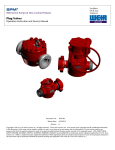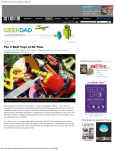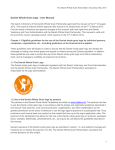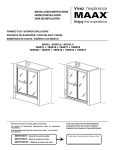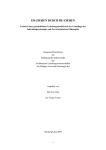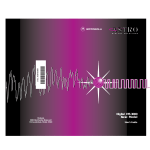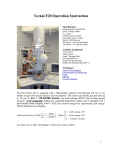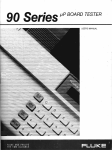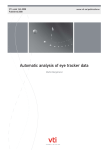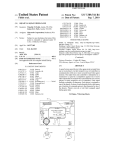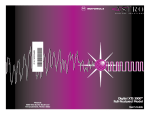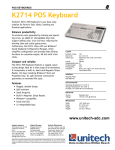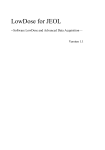Download Dimple Grinder, Model 656 User`s Guide
Transcript
Dimple Grinder, Model 656 User’s Guide Gatan, Inc. 5933 Coronado Lane Pleasanton, CA 94588 Tel (925) 463-0200 FAX (925) 463-0204 November 1998 Revision 2 Part Number: 656.82002 Preface About this Guide This Dimple Grinder User’s Guide is written to provide procedure for the installation of the unit, instruction on basic operations of the unit, procedures for routine maintenance and servicing, and specifics for troubleshooting. The Guide provides the following comment: Note: Used to highlight advice directed at getting the best performance from the equipment. Preview of this Guide The Dimple Grinder User’s Guide includes the following sections: Section 1, “Overview,” provides an overview of the system. Section 2, “Installation,” provides instruction for installation of the unit. Section 3, “Description,” describes the various features and different components within the unit. Section 4, “Operation,” provides instruction for operation of the different components within the unit. Section 5, “Performance Check,” provides instructions on optimization procedures. Section 6, “Electrical Control System,” contains information on the electrical system of the unit. Section 7, “Spares and Consumables,” provides a list of spares and consumables. Dimple Grinder User’s Guide i Disclaimer Gatan, Inc., makes no express or implied representations or warranties with respect to the contents or use of this manual, and specifically disclaims any implied warranties of merchantability or fitness for a particular purpose. Gatan, Inc., further reserves the right to revise this manual and to make changes to its contents at any time, without obligation to notify any person or entity of such revisions or changes. Copyright and Trademarks © Gatan, the Gatan logo is registered to Gatan, Inc. The product names AutoFilter, BioScan, Clipring, DigiPEELS, DigiScan, DigitalMicrograph, DigitalMontage, Duo Mill, DuoPost, Gatan LowDose, GIF, Hexlok, Hexring, HotHinge, MSC, PECS, PIPS, Toggle Tilt, and Whisperlok are trademarks belonging to Gatan, Inc. ii Dimple Grinder User’s Guide Support Contacting Gatan Technical Support Gatan, Inc. provides free technical support via voice, Fax, and electronic mail. To reach Gatan technical support, call or Fax the facility nearest you or contact by electronic mail: • Gatan Inc., USA (West Coast) Tel: Fax: (925) 463 0200 (925) 463 0204 • Gatan Inc., USA (East Coast) Tel Fax: (724) 776 5260 (724) 776 3360 • Gatan GmbH, Germany Tel: Fax: 089 352 374 089 359 1642 • Gatan, UK Tel: Fax: 01536 743150 01536 743154 • Nippon Gatan, Japan Tel: Fax: 0424 38 7230 0424 38 7228 • Singapore Tel: Fax: 65 235 0995 65 235 8869 • Gatan Online http://www.gatan.com [email protected] [email protected] Dimple Grinder User’s Guide iii iv Dimple Grinder User’s Guide Table of Contents Preface i Support iii Table of Contents v List of Figures vii Dimple Grinder, Model 656 1 1.0 Overview 1 2.0 Installation 2 3.0 Description 2 3.1 Control Panel 2 3.2 Measuring Devices 2 3.3 Counterweight 4 3.4 Specimen Rotation Axis 5 3.5 Wheel Types 5 3.6 Raise/Lower Cam 8 3.7 Stereo Microscope 8 3.8 Specimen Mounts 9 4.0 Operation 10 4.1 Adjusting Zero of Dial Indicator 12 4.2 Preparing the Specimen 13 4.3 Specimen Mounting 13 4.4 Specimen Positioning 14 4.5 Set Grinding by Dimple Depth 15 4.6 Set Grinding by Final Thickness 16 4.7 Polishing 19 4.8 Polishing to Final Thickness < 20 µm 20 Dimple Grinder User’s Guide v 4.9 Double-Sided Dimpling 21 4.10 Specimen Removal 21 4.11 Taper Sections 22 5.0 Performance Check 22 5.1 Arm Pivot Friction 23 5.2 Zero Counterweight Scale 23 5.3 Eccentricity (Run-Out) 24 5.4 Vertical Movement of the Specimen Turntable 26 5.5 Grinding Wheel Alignment 26 5.6 Microscope alignment 27 5.7 Zero Stop Adjust 28 6.0 Electrical Control System 29 7.0 Spares and Consumables 30 vi Dimple Grinder User’s Guide List of Figures Figure 1 Dimple Grinder, top view. 3 Figure 2 Measuring devices. 4 Figure 3 Grinding wheel rotation axis. 5 Figure 4 Wheel position alignment. 6 Figure 5 Wheel types. 7 Figure 6 Stereo microscope. 9 Figure 7 Specimen mounts. 10 Figure 8 Set grinding by dimple depth. 16 Figure 9 Set grinding by final thickness. 18 Dimple Grinder User’s Guide vii viii Dimple Grinder User’s Guide Dimple Grinder, Model 656 1.0 Overview The Gatan Model 656 Dimple Grinder is a precision instrument used to produce circular dimples (spherical or flat-bottomed profile) in materials such as ceramics, semiconductors, metals, and combinations thereof. The principle application is in the preparation of TEM specimens. When specimens are mechanically dimpled prior to final thinning, the finished specimen has a more uniform thickness, has a larger than usual electron-transparent area, and is very robust with a thick rim surrounding the central thin region. In the case of neutral-particle beam-thinning systems, the time required for final thinning is significantly reduced with dimpling. With most metals, a 20-µm specimen can be obtained by dimpling and the mechanical damage introduced into the specimen surface by the grinding action is removed with additional final thinning by electro polishing, ion-beam thinning, etc. A final specimen thickness of <5 µm can routinely be produced by a careful operator. The Dimple Grinder is gentle enough and provides sufficient control over the process of dimpling that many materials, such as ceramics and semiconductors, can be thinned below 3 µm with practically no mechanical damage and viewed subsequently in intermediate- and high-voltage TEMs without further thinning. Additionally, the electron-transparent area may be precisely positioned in the specimen, laterally to within a few tens of microns and vertically to within a few microns– not always possible with other dimpling instruments. Other applications of the Dimple Grinder include the production of accurate, precisely-located taper sections through the surface of specimens, which may then be subjected to analytical techniques such as EDX, SIMS, Auger, etc. In this way, compositional profiles of segregated surface layers, coatings, and platings can be obtained rapidly and with excellent “depth resolution.” Dimple Grinder User’s Guide 1 Installation 2.0 Installation The Dimple Grinder operates from the standard mains voltage with no other external services or utilities necessary. However, for reproducible high-quality results, the Dimple Grinder must sit on a flat, vibration-free surface in a relatively clean environment. The Counterweight is packed separately and should be attached by screwing it into position on the Platform. After installation, the zero point of the Counterweight scale should be checked (see Section 5.2). 3.0 Description The base (body) of the Dimple Grinder (see Figure 1) holds the Control Panel, the Micrometer Drive, the Magnetic Turntable with motor drive, the Raise/ Lower Cam, and the Transmission Illumination system. On top of this base sits a pivoted Platform containing the Grinding Wheel assembly, the analog Dial Indicator, and the Counterweight. The Platform, when in the vertical position, is held in place by a magnetic latch (at the rear). With the Platform raised, a stereo microscope can be mounted over the Magnetic Turntable for specimen viewing. 3.1 Control Panel The Control Panel contains the following buttons and dials: Table Arm Lamp Auto Zero Speed (dial) Depress to turn on/off motor for magnetic turntable rotation. Depress to turn on/off motor for dimple wheel rotation. Depress to turn on/off transmission illumination. Depress to turn on/off AutoTerminator. Depress to zero Dimple Depth digital display. Rotate to set dimpling wheel rotation speed. 3.2 Measuring Devices The Dimple Grinder incorporates two measuring devices: 2 • A Dial Indicator with stylus and analog display (see Figure 8). • A Micrometer Drive connected to a digital display (see Figure 2). Dimple Grinder User’s Guide Description Figure 1 Dimple Grinder, top view. 7 5 4 8 6 3 2 9 10 11 Mo del 656 PLE GR IND 1 DIM TA ER BL E AR M LA MP SP 12 EE D 13 ON AU TO ST ZE RO DIM PL ED 19 EP TH OP 14 18 17 16 15 1. 2. 3. 4. 5. 6. 7. 8. 9. 10. Dimple Grinder User’s Guide Zero stop Raise/lower cam control Analog dial indicator Autoterminator socket Pivot platform Load scale Counterweight Microscope socket Wheel motor socket Main power On/Off switch 11. 12. 13. 14. 15. 16. 17. 18. 19. Power On indicator Speed control (wheel) Autoterminator control Dimple depth zero Dimple wheel axle Microscope mount Magnetic turntable Dimple wheel Micrometer drive 3 Description Figure 2 Measuring devices. Analog dial indicator Raise/lower cam control Micrometer drive The Dial Indicator provides indication of contact between grinding wheel and specimen and presents an analog display of dimpling progress. The Micrometer Drive provides a digital readout for setting desired dimple depth or final specimen thickness. The end face of the Micrometer sits directly below the stylus of the Dial Indicator (see Figure 8). When the Micrometer end face is raised (by rotating the Micrometer Drive), it pushes up and raises the stylus by a height change, which is indicated by the dial/digital display. The stylus and the grinding wheel axle are both mounted to the Platform. The raising of the stylus results in a corresponding raising of the grinding wheel. A desired dimple depth (shown in the digital readout) can be set using the Micrometer (see Section 4.5). As dimpling progresses, the “amount of dimpling” can be read on the Dial Indicator. 3.3 Counterweight Located on the back of the Platform is the Counterweight that supplies the variable load (from 0–40 g) applied to the specimen (see Figure 1). The desired load can be selected by dialing in the appropriate value on the scale. Note: When varying the load, be sure to raise the Platform slightly so the Dial Indicator stylus is not on the Micrometer end face. Caution: Dropping the pivoted Platform may cause considerable damage to the measuring devices and will void the warranty. 4 Dimple Grinder User’s Guide Description 3.4 Specimen Rotation Axis The grinding wheel rotation axis (horizontal) is exactly orthogonal to and intersects the specimen rotation axis(vertical). Producing a good dimpled specimen requires the point of contact between specimen and grinding wheel to be on the specimen rotation axis directly below the intersection of the two axes. Precise alignment of the grinding wheel assembly with the specimen ensures that the grinding wheel is within the plane of the specimen rotation axis and hence contacts the specimen at the correct point. Figure 3 Grinding wheel rotation axis. Motion of pivoted platform Grinding wheel Grinding wheel rotation axis Specimen mount Centering ring Specimen Specimen rotation axis The correct configuration is determined by the appropriate wheel diameter and specimen mount assembly. If the diameter of the wheel is too large or too small, the wheel tilts and its rotation axis moves away from the horizontal, which causes the contact point to move away from the vertical specimen rotation axis (see Figure 4). 3.5 Wheel Types There are two types of wheels available with the Dimple Grinder: Dimple Grinder User’s Guide • Grinding wheels • Polishing wheels 5 Description Figure 4 Wheel position alignment. Large grinding wheel β Standard grinding wheel Pivot point of rotating grinding arm Specimen Large grinding wheel contact point Standard grinding wheel contact point Specimen mount Specimen rotation axis Grinding Wheels The grinding wheels are phosphor bronze, available with spherical or flat edges. The spherical-edged wheel permits more accurate positioning of dimples and produces a spherical profile with a smaller thin area. This wheel is more suited to fragile or brittle specimens, such as ceramics and semiconductors. The flat-edged wheel produces flat bottomed dimples with larger thin regions and is better suited to tougher specimens, particularly metals. Wheels come in different sizes. The small wheel preserves a wide, thick rim around the thin area for fragile specimens and produces steep profiles for analysis. The large wheel prepares bulk specimens for larger thin areas. All wheels are interchangeable. Note: The grinding wheels wear and are considered consumable items. Polishing Wheels The polishing wheel consists of male and female parts that hold a central felt polishing ring (see Figure 5). 6 Dimple Grinder User’s Guide Description Figure 5 Wheel types. Spherical rim grinding wheel, 10 mm, 15 mm, and 20 mm or Flat rim, grinding wheel, 15 mm only Grinding wheel Spherical Flat Dimple wheel axle Thumb screw Durlon rim polishing wheel 10 mm, 15 mm, and 20 mm Dimple wheel axle Thumb screw Felt ring The following table presents the material and sizes of the different wheels: Wheels Grinding Polishing Material Phosphor bronze Male/female parts supporting a felt ring Edges Size (mm) Spherical 10 15 (standard) 20 Flat 15 10 15 (standard) 20 Note: The polishing rings have a limited lifetime and should be replaced regularly. Take care not to get the felt polishing rings contaminated and do not mix different polishing compounds on the same ring. Caution: Be careful to ensure that the male and female surfaces of the wheels and axle assembly are kept clean. Do not flood the male taper with solvents to clean the axle, as this may flush grit or compounds into the axle assembly leading to wear and impaired performance. Clean the axle with a lens tissue lightly Dimple Grinder User’s Guide 7 Description moistened with water or a solvent (e.g., acetone) if the contamination is difficult to remove. 3.6 Raise/Lower Cam The Raise/Lower Cam allows the Platform (and the grinding wheel) to be very gently lowered and must always be used to raise or lower the Platform through the final part of its movement. To lower the Platform 1. Rotate the Raise/Lower Cam toward the back. This will rotate the Cam stop to the rear. 2. Manually lower the Platform as far as it will go. 3. Rotate the Raise/Lower Cam slowly toward the front. This will rotate the Cam stop to the front and in the process gently lower the grinding wheel onto the specimen for the last few microns of grinding. 3.7 Stereo Microscope The stereo microscope (see Figure 6) projects a true image and is designed to accurately fit the microscope mount around the Magnetic Turntable. The cross hair within the eyepiece is aligned to the center of rotation of the Turntable. By selectively positioning the specimen, the microscope can be precisely located on a specific feature. Illumination The stereo microscope, which plugs into the light socket left of the Control Panel (see Figure 1), contains both a Reflection and Transmission Illumination systems. Certain materials that become transparent during final thinning may, when mounted to glass specimen mounts, be observed by the Transmission Illumination system. Depress the LAMP button on the Control Panel to turn off the “reflected” microscope lamp and turn on the “transmitted” lamp mounted beneath the Turntable. A beam will be projected through the center hole in the Turntable and illuminate the specimen from below. 8 Dimple Grinder User’s Guide Description Figure 6 Stereo microscope. View through microscope Microscope field-of-view, 60X Align circular spot with microscope crosshairs Circular spot generated by grinding wheel X left adjust Adjustment tool Y adjust X right adjust Specimen mount Centering ring Microscope mount 3.8 Specimen Mounts The specimen mount is held in position by a centering ring on the Magnetic Turntable. To accommodate the various diameter grinding and polishing wheels, three different, appropriately-sized mounts are available to insure the proper grinding-wheel axis orientation (see Figure 7). The standard mount, for use with the standard 15-mm diameter wheel, is cylindrical in shape and made of stainless steel. Opaque specimens are normally mounted on the stainless-steel mount. For transparent specimens or for materials that become transparent when very thin, such as silicon, a glass (pyrex) specimen mount is available that allows the progress of thinning to be monitored in transmitted light. Dimple Grinder User’s Guide 9 Operation Figure 7 Specimen mounts. 10-mm grinding wheel Specimen mount (stainless steel) Microsope mount 15-mm grinding wheel Specimen mount (pyrex or stainless steel) Centering ring Microsope mount 20-mm grinding wheel Specimen mount (pyrex or stainless steel) Centering ring Microsope mount The specimen mount for use in conjunction with the small, 10-mm diameter wheel has a conical shape to prevent fouling of the grinding wheel axle assembly. The specimen mount for the large, 20-mm diameter wheel is a simple disc. Note: The specimen mounts should be periodically checked for smoothness and flatness. This may be done either with the stereo microscope or a free-standing dial indicator. 4.0 Operation There are two methods by which specimens can be dimpled: • 10 Set grinding by dimple depth. Dimple Grinder User’s Guide Operation • Set grinding by final specimen thickness. Both methods are based on the interaction of the Micrometer Drive and the analog Dial Indicator. The Dimple Depth digital display shows the desired dimple depth set by lowering the end face of the Micrometer Drive. The analog Dial Indicator shows the progress of grinding and displays the thickness of specimen material remaining to be removed. When the Dial Indicator stylus makes contact with the micrometer end face, grinding is terminated by the AutoTerminator, which will automatically switch off the wheel and specimen turntable motors (see Figure 8). The rate of removal of material by grinding depends on several factors. Generally, increasing the load and/or grinding wheel speed will increase the rate of material removal. However, this will also produce a thicker damaged layer. It should also be noted that some hard metals work harden significantly and these are best dimpled at a slow speed with reduced load. Grinding by Dimple Depth This method is used when very thin (<20µm) specimens are being dimpled. The Micrometer is first zeroed on the upper surface of the specimen and the desired dimple depth is set with the Micrometer Drive and value read on the digital display. The initial thickness of the specimen must be known. This method is the most accurate way to grind specimens but it is necessary to zero the Micrometer for each specimen. See Section 4.5 for more detailed instruction on this method. Grinding by Final Specimen Thickness This method is less accurate than the “dimple depth” method and is not recommended for very thin specimens. The Micrometer is first zeroed on the upper surface of a specimen mount without any specimen. The mount is replaced with a mount with a specimen and the desired amount of material to be removed is dialed in using the Micrometer Drive. The advantages of this method are the initial thickness of the specimen need not be ascertained and the Micrometer is zeroed only once when dimpling a number of specimens. Dimple Grinder User’s Guide 11 Operation The disadvantages are the inaccuracies that are not taken into account, i.e., specimen mount may not seat at precisely the same height each time; the main “variable” thickness of the mounting wax. See Section 4.6 for more detailed instruction on this method. 4.1 Adjusting Zero of Dial Indicator Note: The zero of the Dial Indicator should always be checked prior to dimpling. The care with which the zero is set will determine the accuracy of the measuring systems. To zero the Dial Indicator 1. Raise the Platform to the upright position, Remove the specimen mount (if any) from the Magnetic Turntable. Check that both motors (TABLE and ARM buttons on Control Panel) are off. 2. Set a load of 20 g on the Counterweight. 3. Lower the Platform onto the Raise/Lower Cam stop. Be sure the Cam stop is in the “rear” position. 4. Lower the micrometer end face by rotating the Micrometer Drive (clockwise) until it bottoms against the base. 5. Use the Raise/Lower Cam and carefully lower the Platform. When lowered, the Cam stop is in the “front.” 6. Raise the micrometer end face by rotating the Micrometer Drive counter-clockwise. Rotate (several revolutions) until the Dial Indicator needle registers and rotates one complete turn coming to rest at or near the 12 o’clock position. Note: It is not necessary for the needle to be exactly at the 12 o’clock position. However, if it does stop more than ± 10µm away from 12 o’clock position, perform the Zero Adjust procedure (see Section 5.7). For small zero adjusts, use the 3/32 hex wrench on the zero stop screw (see Figure 1) and rotate to center needle. 7. Verify with Digital Display reading. Rotate the Micrometer Drive (clockwise) to position the needle on “100” and see that the Digital Display reads 0.100. Return the needle to zero. The Dial Indicator is properly zeroed. 12 Dimple Grinder User’s Guide Operation 4.2 Preparing the Specimen Here are some initial criteria that should be met to successfully prepare a specimen for dimpling: • Starting specimens should have perfectly parallel faces prior to dimpling. • The glue layer should be of uniform thickness. • The specimen surface in contact with the specimen mount should have a good finish. Thickness Issues Any variation of thickness of the starting disc can easily be determined by visually noting the change in focus across the disc when observed by the optical microscope. A deviation of 1° will result in approximately a 25-µm overestimate of the thickness of a 3-mm disc when measured with a micrometer— clearly unacceptable if attempting to produce a 5-µm dimpled specimen. Regardless of the dimpling method used, accurate determination of the recommended initial 80-µm thickness is necessary. This thickness will reduce the time needed for dimpling, yet still provide a sufficiently strong supporting rim that allows for subsequent ion milling at low angles. Dimpling Techniques For normal dimpling, disc grinding can be completed using 5-µm paper but for thinning of specimens to less than 20 µm, the final stage of disc grinding should be done with a 3-µm diamond paste. If mechanically thinning to electron transparency, the disc should be finished on a polishing cloth with 3-µm diamond paste followed with 0.05-µm alumina. Alternatively, a good surface finish can be obtained for the flat side using the dimple polishing technique (see Section 4.8). 4.3 Specimen Mounting The specimen is normally fixed to the mount with a low melting-point, thermoplastic wax. The wax supplied by Gatan is liquid at 130 °C. Note: If the temperature of the wax is allowed to exceed 130 °C it will begin to decompose. While this may not appear to affect its adhesive strength, the specimen may become detached later, during grinding. (The Gatan Specimen Mounting Hot Plate is recommended.) Care must also be taken to keep the wax perfectly clean and free from dirt. Particles as small as a few microns between the specimen and the mount will adversely affect performance. Dimple Grinder User’s Guide 13 Operation To mount a specimen 1. Place the specimen mount on the 130 °C hot plate. 2. After 5 min, touch the end of a wax stick against the surface of the mount. Only a small quantity (about 1-mm diameter) is necessary. Allow the wax to melt and flow. 3. Carefully place the specimen onto the wax, polished surface down. 4. Gently press the specimen onto the mount with a toothpick. Move the specimen in small circles to ensure that the wax is evenly and thinly distributed. Avoid getting wax on the upper surface of the specimen. 5. Remove the specimen mount from the hot plate and allow to cool. 6. Use chloroform or acetone and a cotton swab to gently remove excess wax from around the specimen on the specimen mount. Note: Until you have perfected the technique for mounting specimens, check the thickness of the wax layer. It should be less than 3 µm. 4.4 Specimen Positioning The Magnetic Turntable allows the dimple to be located at any point on the specimen disc. However, unless there is a reason to do otherwise, the dimple should be positioned close to the center of the disc to obtain the maximum benefit of a supporting rim. To position specimen 1. Place the specimen mount (and centering ring) onto the magnetic turntable. The Magnetic Turntable, bottom of the specimen mount, and centering ring may be wiped with lint-free paper moistened with a small amount of vacuum grease to remove any dirt and to ensure these items slide freely on the Magnetic Table. 2. Gently position the microscope onto its mount. 3. Insert the miniature plug into the light socket. 4. Adjust the microscope eyepiece for comfortable viewing and focus onto the specimen. 14 Dimple Grinder User’s Guide Operation 5. Position the specimen mount (and centering ring) until the desired feature on the specimen coincides with the cross hair. 6. Check correct centering by turning on the Turntable Motor. The desired dimpled center should rotate about the cross-hair center. Remove microscope when complete. 4.5 Set Grinding by Dimple Depth One method of dimpling is to set grinding by dimple depth. To set grinding by dimple depth 1. Set the Counterweight load (20 g) and select a mid-range grinding speed. 2. Determine initial specimen thickness. 3. Check that both motors (TABLE and ARM buttons on Control Panel) are off. 4. Lower the micrometer end face by rotating the Micrometer Drive (clockwise). 5. Place the mount plus specimen and centering ring on the Magnetic Table. Carefully lower the grinding wheel onto the specimen with the Cam. 6. Raise the micrometer end face. Rotate the Micrometer Drive until the dial indicator needle has rotated one complete turn and just reaches zero. Note: Take care not to raise the Micrometer Drive past zero. 7. Press the ZERO button to zero the Dimple Depth digital display. 8. Lower the micrometer end face (rotate Drive clockwise) until the digital display reads the required dimple depth. The Dial Indicator will show the thickness of material yet to be removed. 9. Place a small amount of diamond compound onto the wheel and the specimen using a toothpick, then moisten with distilled water. 10. Turn on both motors. Dimple Grinder User’s Guide 15 Operation Figure 8 Set grinding by dimple depth. 0 Analog dial indicator Zero stop Micrometer head raised. Digital display zeroed. Grinding wheel Specimen mount with specimen Spring loaded stylus 0.000 Digital display Material to be removed, 100 µm (dimple depth) 100 µm Micrometer head lowered 100 µm 0.100 11. The AutoTerminator may now be switched on (AUTO button). When the Dial Indicator is within 2-3 µm of zero, the Autoterminator will automatically switch off the specimen turntable and grinding wheel motors. Grinding of the remaining 2-3 µm may be done with reduced load and grinding speed. Note: A small pocket of dilute paste should be present on the specimen at all times and the specimen surface and grinding wheel must not be permitted to dry out. Also, it is recommended the wheel and specimen be occasionally cleaned and fresh diamond compound applied. 4.6 Set Grinding by Final Thickness Another method of dimpling is to set grinding by final thickness. To set grinding by final thickness 1. Set the Counterweight load (20 g) and select a mid-range grinding wheel speed. 16 Dimple Grinder User’s Guide Operation 2. Check both motors (TABLE and ARM buttons on Control Panel) are off. 3. Lower the Micrometer Drive end face (clockwise). 4. Place centering ring and the specimen mount, without specimen, on the Magnetic Table. Carefully lower the grinding wheel (use the Cam) onto the specimen mount. 5. Raise the Micrometer Drive until the dial indicator needle has rotated one complete turn and just reaches zero. Note: Take care not to raise the Micrometer Drive past zero. 6. Press the ZERO button to zero the Dimple Depth digital display. This setting may be used for any number of specimens. 7. Carefully raise the Platform. Remove the specimen mount and replace it with one having a specimen attached. 8. Raise the micrometer end face (rotate Drive counter clockwise) until the display shows the required final thickness. The reading on the digital display will be negative. 9. Use the Cam and carefully lower the grinding wheel onto the specimen. The Dial Indicator now displays the thickness of material to be removed. This value plus the digital display reading represent the combined thickness of the specimen plus the thickness of the mounting wax. 10. Place a small amount of diamond compound onto the wheel and the specimen. Use a toothpick for the compound and then moisten with distilled water. 11. Turn on both motors. 12. The AutoTerminator may now be switched on (AUTO button). When the Dial Indicator is within 2-3 µm of zero, the Autoterminator will automatically switch off the specimen turntable and grinding wheel motors. Grinding of the remaining 2-3 µm may be done with reduced load and grinding speed. Note: A small pocket of dilute paste should be present on the specimen at all times and the specimen surface and grinding wheel must not be permitted to dry out. Also it is recommended the wheel and specimen be occasionally cleaned and fresh diamond compound applied. Dimple Grinder User’s Guide 17 Operation Figure 9 Set grinding by final thickness. 0 Analog dial indicator Zero stop Micrometer head raised. Digital display zeroed. Grinding wheel Specimen mount without specimen Spring loaded stylus 0.000 Digital display Specimen mount with specimen 0.000 T µm Final specimen thickness, 15 µm Micrometer head raised 15 µm -0.015 18 Dimple Grinder User’s Guide Operation 4.7 Polishing When grinding has reduced the specimen thickness to within a few microns of the final thickness, the grinding wheel is replaced with a felt polishing wheel. Generally, a polishing treatment improves the final specimen quality obtainable with subsequent ion milling. To polish 1. Remove the grinding wheel and wipe the axle with a clean lens tissue. If the contamination is difficult to remove, lightly moisten the tissue with water or a solvent (e.g., acetone). Caution: Do not flood the male taper with solvents to clean the axle as this may flush grit or compounds into the axle assembly and lead to bearing wear and impair performance. 2. Remove the specimen mount from the Turntable. Thoroughly clean the specimen of all grinding compound. Use a cotton swab and distilled water followed by flushing with acetone. 3. Carefully mount the polishing wheel onto the axle. 4. Place the specimen mount back onto the Turntable and center using the microscope. Precise centering is unnecessary for the final polishing step. 5. Set a higher rotational speed for polishing and set a load of about 30 g. 6. Apply a small quantity of 2–4 µm diamond paste to both the felt wheel and specimen. Note: Take care not to get the felt polishing rings contaminated and do not mix different polishing compounds on the same ring. 7. Gently lower the polishing wheel onto the specimen. Polish until the surface finish is improved (normally requires only a few minutes). 8. Use a new felt wheel and repeat with 0.05-µm alumina. Polish until the surface is free of scratches produced by the 2–4 µm diamond paste. Note: The softness of the felt polishing wheels makes the measuring system inaccurate. From time to time, monitor the polishing progress with the stereo Dimple Grinder User’s Guide 19 Operation microscope. The exact time needed to polish the specimen will vary depending on hardness. 4.8 Polishing to Final Thickness < 20 µm Producing a dimpled area of < 20 µm thickness requires extended polishing with the felt wheel. The specimen has to be first coarsely polished and finished with a fine polish. The micrometer is not used because the softness of the felt makes it impossible to obtain an accurate reading. Dimpling progress can be easily monitored for specimens on glass mounts when viewed in transmitted light on the microscope. In the case of semiconductors, the color of the specimen as seen with transmitted light is closely related to thickness. For silicon, red indicates a thickness of about 10 µm while yellow indicates a thickness around 5 µm for (100) orientation. 4.8.1 Coarse Polishing When a specimen thickness of 15-20 µm has been reached by grinding, the specimen is thoroughly cleaned and the grinding wheel replaced with a felt polishing wheel. The object of the coarse polishing stage is to remove the scratches and other mechanical damage resulting from grinding and to produce a specular surface. To coarse polish • Set the Counterweight to 20 g and the wheel speed to mid range. • Use a 2–4 µm diamond compound on the specimen and the wheel. Silicon normally requires coarse polishing for about 5 minutes. This time should be split into short periods interspersed by cleaning of the specimen and wheel with a cotton swab and distilled water followed by acetone or other solvents. 4.8.2 Fine Polishing The object of the fine polishing stage is to very gently reduce the specimen thickness to less than 2 µm. The specimen must be completely cleaned of all traces of the previous polishing compound. Lack of care in accomplishing this will make it impossible to thin the specimen as required. To fine polish 20 • Mount a new, clean felt polishing wheel. • Set the Counterweight to 20 g and the wheel speed to mid range. Dimple Grinder User’s Guide Operation • Use 0.05-µm gamma-alumina suspension polishing compound. The time necessary to complete fine polishing will depend on the initial and final thicknesses and the specific material. Silicon will normally take 15–20 min to achieve a thickness of 2-3 µm. As with coarse polishing, this time should be broken into short periods, interspersed by occasional cleaning and careful monitoring of the progress of polishing. 4.9 Double-Sided Dimpling Dimpling the specimen on both sides prior to further thinning allows the electron-transparent area to be positioned at a selected depth in the specimen for viewing interfaces. Additionally, the residual stresses are better balanced. It is necessary to accurately know the original specimen thickness and only grind by setting a known dimple depth. Obviously, the depth of the two dimples must be set so that together they come to less than the original specimen thickness. To do double-sided dimpling 1. After dimpling the first side, the specimen is removed from the mount. Note: Thoroughly clean the specimen of all wax in order to ensure the accuracy of the measuring system. Care must be taken in mounting the specimen for the second time to ensure that no air bubble is trapped in the lower dimple. Otherwise, the unsupported thin area will collapse. 2. Place a clean specimen mount on a hot plate set at 130 °C. 3. Place the specimen, dimpled side up, onto the hot plate to warm up the specimen. 4. Melt a small amount of wax at the center of the specimen mount and into the dimple of the specimen. 5. Carefully flip over the specimen with a fine pair of tweezers and gently place it into the melted wax on the specimen mount. 6. Set the correct dimple depth on the Micrometer Drive. 7. Proceed as for normal dimpling. 4.10 Specimen Removal Once dimpling has been completed on both sides, the specimen is removed from the mount. Extreme care is required to prevent damage to the thinned area. Dimple Grinder User’s Guide 21 Performance Check To remove specimen 1. Remove the specimen mount from the Magnetic Turntable. 2. Place the specimen mount on a hot plate set at 130 °C. 3. Allow the wax to completely melt, then slide the specimen off the mount with a cocktail stick. 4. Remove the mounting wax from the specimen. Immerse in several acetone washes till the specimen is thoroughly clean. Note: The use of an ultrasonic cleaner is not recommended since it may damage some specimens. 4.11 Taper Sections Dimpled specimens are ideal for analysis of surface segregation, platings, coatings, etc. Dimple depth into the specimen is represented by the following equation: Depth = x (2r - x)/2R where: R r x = wheel diameter, = dimple radius, = distance from the edge of the dimple. This approximation always gives a value slightly less than the correct value, with a maximum error of less than 10%. The correct value is given by: Depth = {R2-(r-x)2}1/2- {R2-r2}1/2 5.0 Performance Check A complete check of the performance of the Dimple Grinder comprises, in addition to the Dial Indicator zero check (see Section 4.1), the following operations: 22 • Checking arm pivot friction. • Zeroing Counterweight scale. • Adjusting eccentricity (run-out). • Checking vertical movement of specimen turntable. • Aligning grinding wheel and stereo microscope. Dimple Grinder User’s Guide Performance Check • Adjusting zero stop. 5.1 Arm Pivot Friction To achieve an accurate response of the measuring system, the friction in the Platform pivots must be very low. To check arm pivot friction 1. Lift the Platform off the Micrometer Drive. 2. Disconnect the two wires leading to the Platform. Temporarily secure them to the Platform with tape. 3. With the tip of a finger, support the Platform at about 20° above horizontal. Caution: Take care not to drop the Platform. 4. Adjust the balance of the Platform with the Counterweight until the Platform is exactly balanced at this position. Adjustment of the counterweight by ±2 g should cause the Platform to gently fall towards the horizontal or rise to about 60°. Note: This is not the zeroing of the Counterweight scale. 5.2 Zero Counterweight Scale The load scale is friction coupled to the Counterweight and is free to rotate and slide. To set the zero of the load scale, account is taken of the spring tension in the Dial Indicator stylus and the weight of the grinding wheel. Note: Ensure that the Dial Indicator has been zeroed, a grinding wheel is mounted to the axle, and the Platform is down. To zero Counterweight scale 1. Disconnect the two wires leading to the Platform. Temporarily secure them to the Platform with tape. 2. Screw the Counterweight in fully until it stops. 3. Rotate and slide the black load scale to align its zero to the zero on the Counterweight. 4. Raise the Platform off the Micrometer Drive. Support the Platform at approximately 30° above horizontal. Dimple Grinder User’s Guide 23 Performance Check Unscrew the Counterweight sufficiently to balance the Platform at this point. 5. Screw the Counterweight in two full turns. This applies the necessary load to overcome the stylus spring and the weight of the wheel. 6. Lower the Platform onto the Micrometer end face. The Dial Indicator needle will rotate clockwise and creep towards zero when the dimple grinder base is gently tapped. If the needle does not reach zero, increase the load by 1-g increments until the needle slowly and smoothly reaches zero. If the needle rotates hard towards zero, reduce the load until the needle settles within one division of zero. 7. Raise the Platform. Firmly hold the Counterweight and rotate and slide the black load scale to align the zeros. It should be possible to position the Dial Indicator needle within one division of zero by adjusting the Counterweight no more than ± 2g from the load scale zero. 5.3 Eccentricity (Run-Out) Excessive vertical movement of the Platform makes it impossible to accurately monitor the progress of dimpling and to determine the final thickness. This vertical movement is due to run-out (play in the wheel), which can be attributed to either the axle, a specific wheel, or a combination of both. The axle must first be tested without a wheel since any axle run-out would be added to any wheel runout, thus compounding the problem. To check run-out of axle assembly 1. Remove any wheel that may be mounted to the axle. Carefully clean the axle surface with a tissue. Caution: Do not flood the axle with solvent, as this may wash grit into the axle bearings. 2. Place the axle calibration post (Accessories Kit) into the centering ring and place both on the Magnetic Table. Use the cross hair of the microscope to center the post. 3. Set a Counterweight load of 20 g. 24 Dimple Grinder User’s Guide Performance Check 4. Switch on the wheel motor; adjust the rotation speed to the lowest setting. 5. Carefully lower the Platform. 6. Adjust the Micrometer Drive to obtain a reading on the Dial Indicator. 7. The reading on the Dial Indicator must change by no more than 2 µm. Should the run-out be significantly greater than this amount, you may want to consider replacing the bearing assembly depending upon the outcome of the Axle/Grinding Wheel combination. To check run-out of axle and wheel assembly 1. Clean male and female wheel bearing surfaces. Carefully clean the wheel surfaces with lint-free tissue moistened with solvent and mount one of the grinding wheels. Caution: Do not flood the axle with solvent, as this may wash grit into the axle bearings. 2. Place a stainless steel specimen mount into the centering ring and place both on the Magnetic Table. 3. Set a Counterweight load of 20 g. 4. Switch on the wheel motor; adjust the rotation speed to the lowest setting. 5. Carefully lower the Platform onto the specimen mount. 6. Adjust the Micrometer Drive to obtain a reading on the Dial Indicator. 7. The reading on the Dial Indicator must change by no more than 2 µm. If the reading is greater than 2 µm, you can: Dimple Grinder User’s Guide • Find the point on the wheel that produces the highest fluctuation. Mark the wheel at this point and rotate the wheel with respect to the axle to find an alignment which produces the minimum fluctuation (run-out). • Check that the grinding wheel does not have a flat. If it does, the wheel must be replaced. • Try another grinding wheel. If this solves the problem, the female wheel bearing surface is damaged and the wheel should be discarded. • If the same run-out occurs with other wheels, either the male taper bearing surface is damaged or the axle assembly is damaged or worn. 25 Performance Check Minor damage to the axle male taper can be repaired by turning on the motor at full speed, placing a minute quantity of diamond compound into the female taper of a wheel and carefully lapping the two. Do not permit the diamond compound to go beyond the wheel edge. • If excessive run-out persists, the axle assembly must be replaced. 5.4 Vertical Movement of the Specimen Turntable Excessive vertical movement of the specimen turntable causes similar problems to excessive run-out of the grinding wheel axis. To check for turntable vertical movement 1. Remove any wheel that may be mounted to the axle. Carefully clean the axle surface with a tissue. Caution: Do not flood the axle with solvent, as this may wash grit into the axle bearings. 2. Place a stainless steel specimen mount into the centering ring and place both on the Magnetic Table. Use the cross hair of the microscope to center the post. 3. Set a Counterweight load of 20 g. 4. Switch off the wheel motor; turn on the turntable motor 5. Carefully lower the Platform. 6. The reading on the Dial Indicator must change by no more than 2 µm total (TIR). If the reading is greater than this value, you can: • Check that the turntable surface and specimen mounts are clean. • If the cause of the vertical movement cannot be identified, the complete turntable assembly must be replaced. 5.5 Grinding Wheel Alignment As discussed in Section 3.4, the contact point of the grinding wheel must be on the rotational axis of the Magnetic Turntable. This configuration is more critical for spherical-edged wheels than for flat-edged wheels. 26 Dimple Grinder User’s Guide Performance Check To align grinding wheel 1. Set up the Dimple Grinder as for grinding a specimen. 2. Turn on both the specimen turntable and grinding wheel motors. 3. Carefully lower the grinding wheel onto the surface of a smooth, stainless steel, specimen mount. Verify by the Dial Indicator that contact is made between wheel and mount. Let it run for a few seconds. 4. Raise the Platform to its upper position. 5. Switch off both motors. 6. Place the stereo microscope over the Magnetic Turntable. Ensure that it is properly seated. 7. The point of contact should be visible on the specimen mount surface. The contact point should be a small circular spot centered within the cross hair of the stereo microscope. Note: Should the point of contact appear as a ring instead of a spot, it indicates the pivoted Platform is out of alignment. This is a factory sealed adjustment which the user should not attempt to correct. Contact a Gatan service representative. 5.6 Microscope alignment If the contact point (Item 7 above) is not centered, proceed as follows to align the microscope. 1. Use the tool provided with the microscope to rotate the “Y” adjust screw (see Figure 6). This will move the cross hair front-to-back relative to the spot centerline. 2. Use the “X” left/right adjust screws to shift the cross hair relative to the spot centerline. 3. Switch on the specimen turntable and confirm the center of rotation corresponds to the optical axis of the microscope (cross hair). Dimple Grinder User’s Guide 27 Performance Check 5.7 Zero Stop Adjust This procedure should only be performed if the Dial Indicator needle zero position is more than ± 10 µm away from the 12 o’clock position when the zero adjustment screw is flush with its housing. To adjust the zero stop 1. Rotate Raise/Lower Cam toward the back of the unit. 2. Turn the Micrometer Drive to the extreme clockwise position. 3. With the 3/32 hex wrench provided, screw in the zero stop screw until flush with its housing. 4. Unscrew zero stop screw 1 1/2 turns (counter-clockwise rotation). 5. Raise the pivoted Platform. 6. Push (from below) the stylus of the Dial Indicator against the zero stop screw, overriding the clutch. Push with the hex wrench. 7. Screw in the zero stop screw until it is flush with its housing. 8. Screw in the zero stop screw an additional 3/4 turn clockwise, then back to the flush position. This will set the clutch. 9. Gently lower the Raise/Lower Cam. 10. Rotate the Micrometer Drive counter clockwise until the Dial Indicator needle stops moving. 11. Carefully adjust the zero stop screw clockwise until the Dial Indicator needle is at the 12 o’clock position. At this point, the Dial Indicator and micrometer readings should correspond. If the zero stop screw is not flush (±.15mm), some error will occur due to the angle of the indicator arm. 28 Dimple Grinder User’s Guide Electrical Control System 6.0 Electrical Control System The Dimple Grinder is powered by a 24 Vdc desktop power module that operates on input voltages ranging from 90 to 260 VAC at frequencies of 50 or 60 Hz. It is also current limited at 1.25 A, so there is no need for a fuse in the system. A molded power cord is supplied with the unit to fit the local standard power socket. If the power cord supplied is not compatible with local standards, the plug should be replaced with a suitable one. Before connecting the new plug, make sure the voltage requirement conforms to that specified on the label on the rear panel of the unit. The wiring color codes should conform as shown: Live Black or Brown Neutral White or Blue Ground Green or Green/Yellow To access the baseplate and PCB 1. Unplug the DC plug from the rear of the Dimple Grinder. 2. Remove the single flathead socket screw on the base. Raise the Platform to its vertical position to expose the flathead socket screw. Use the 3/32 hex wrench to remove this screw. 3. Expose the PC board. Pull off the SPEED control knob and lift off the Control Panel to expose the PC board. 4. Remove the two mounting screws in the electrical connector at the back of the PC board. 5. The upper casing of the Dimple Grinder will now lift completely off. The main PC board is fixed to the Dimple Grinder baseplate and contains the transmission illuminator, the motor speed control, 1.5V supply, and the AutoTerminator circuit. When AUTO (S4) is depressed, capacitor C2 charges pulling in the relay K1 closing contacts K1-1. These contacts apply holding (latching) power to K1 (via dropping resistor R6) and also the motor power to switches S1 and S2. As the specimen reaches the grinding limit, the stylus S6 goes to ground, shorting out the holding power for K1 causing it to drop out thus removing power from the motors. To reset the relay the capacitor C2 must be discharged by pressing the AUTO switch to the UP position. Dimple Grinder User’s Guide 29 Spares and Consumables 7.0 Spares and Consumables Spares 03368 623.00082.0 623.00084.0 623.00152.0 623.00154.0 656.01050 656.01160 656.01260 656.01370 656.01400 656.01410 656.01500 656.03100 656.03160 656.07061 656.07062 656.07063 656.07064 656.07065 656.07066 656.07350 656.07511 656.07512 656.07513 Illuminator bulbs, x5 Specimen mount for 15-mm wheel (Pyrex) x4 Specimen mount for 15-mm wheel (stainless steel) x4 Specimen mount for 20-mm wheel (Pyrex) x4 Specimen mount for 20-mm wheel (stainless steel) x4 Grinding wheel motor Specimen mount for 10-mm wheel (stainless steel) x4 Grinding wheel clamping screw Drive coupling Centering ring, for use with 623-0008 specimen mount Centering ring, for use with short specimen mount (20-mm and 15-mm wheels) Grinding wheel bearing assembly PC board Turntable motor with gearbox Spherical grinding wheel, phosphor bronze, 10-mm wheel, x4 Spherical grinding wheel, stainless steel, 10-mm wheel, x4 Spherical grinding wheel, phosphor bronze, 15-mm wheel, x4 Spherical grinding wheel, stainless steel, 15-mm wheel, x4 Spherical grinding wheel, phosphor bronze, 20-mm wheel, x4 Spherical grinding wheel, stainless steel, 20-mm wheel, x4 Flat grinding wheel 15-mm only, phosphor bronze, x4 Polishing wheel, 10-mm diameter, x4 Polishing wheel, 15-mm diameter, x4 Polishing wheel, 20-mm diameter, x4 Consumables 06527 06995 06996 623.01100.0 656.04010 656.07541 656.07542 656.07453 30 Diamond polishing compound, 2–4 µm, 5-g syringe Cubic boron nitride (CBN) polishing compound, 0–2 µm, 5-g syringe Cubic boron nitride (CBN) polishing compound, 4–6 µm, 5-g syringe Mounting wax (12 rods, 3.5 mm x 32 mm) Alumina polishing suspension, 0.05 µm (2 oz) Felt polishing ring for 656.07511, 10-mm diameter, x15 Felt polishing ring for 656.07512, 15-mm diameter, x15 Felt polishing ring for 656.07513, 20-mm diameter, x15 Dimple Grinder User’s Guide Spares and Consumables Accessories 601.07000 623.40001 623.40002 656.0150T Dimple Grinder User’s Guide TEM Specimen Cross-Section Kit Specimen mounting hot plate (120 V) Specimen mounting hot plate (240 V) Axle calibration post 31 Spares and Consumables 32 Dimple Grinder User’s Guide Index C R Control panel 2 Counterweight 4 Raise/Lower cam 8 S D Dial indicator 4 zeroing 12 Specimen mounting 13 polishing 19 coarse 20 fine 20 E Micrometer drive 4 positioning 14 removal 21 Specimen mounts 9 Specimen preparation dimpling techniques 13 double-sided dimpling 21 taper sections 22 thickness issues 13 Specimen rotation axis 5 Stereo microscope 8 alignment 27 illumination 8 O W Overview 1 Wheel type grinding 6 polishing 6 Electrical control system 29 G Grinding by dimple depth 11, 15 by final specimen thickness 11, 16 I Installation 2 M P Performance check arm pivot friction 23 eccentricity (run-out) 24 grinding wheel alignment 26 turntable vertical movement 26 zero counterweight scale 23 zero stop adjust 28 Dimple Grinder User’s Guide I-1 I-2 Dimple Grinder User’s Guide Gatan Distributors and Agents Argentina Coasin S.A. Virrey Del Pino 4071 1430 Buenos Aires, Argentina 011-54-1-551-9361 552-3485/3185/5248 011-54-1-555-3321 Hungary Auro-Science Consulting Kft. 1031 Budapest, Varosfal Koz 5. Budapest, Hungary 011-36-1-173-0166 011-36-1-242-1390 011-36-1-242-1391 Mexico IACSA de C.V. Insurgentes Sur #3807-3 Tlalpan, CP 14269 Mexico, D.F. Mexico 011-525-666-4149 011-525-666-4149 Electrargen S.R.L. Amenabar 653 Piso 9° Of. 27 1426 Buenos Aires, Argentina 011-54-1-553-5376 011-54-1-555-5376 India Harley Instruments Plot 4, Survey 47 Poona-Satara Road, Poona 411 009, India 011-91-212-435-962 011-91-212-477-843 Instrumentos OPTO-electronicos Larga Distnacia No. 87 Col. Ampliacion Sinatel Mexico DF 09470, Mexico 011-525-672-2537 011-525-672-2616 Toshniwal Bros. (SR) Pvt. Ltd. #11, AECS Layout, 4th Main, 3rd Cross Geddalshalli, Sanjaynager 1 Stage Bangalore 560-094, India 011-91-80-333-7983 011-91-80 333-6757 Norway Micron AS Box 1133 Cort Adlers Gate 8 N-1510 Moss, Norway 011-47-6927-4690 011-47-6927-1210 Australia Thomson Scientific Inst. 216 Drummond Street Carlton, VIC 3053, Australia 011-61-3-9663-2738 011-61-3-9663-3680 Brazil Fugiwara Enterprises Rua Desembargador Guimaraes, 53 05002-050 S. Paulo, SP, Brazil 011-55-11-3675-3605 011-55-11-3675-3603 Canada Soquelec Limited 5757 Cavendish Blvd., Suite 101 Montreal, Quebec H4W 2W8, Canada 1-514-482-6427 1-514-482-1929 Israel Eisenberg Brothers Ltd. 13 Gush Etzion Street Giv’at Shmuel 54030 Israel 011-972-3-532-1715 011-972-3-532-5696 General Engineers Ltd. P O Box 557 Herzliya 46105, Israel Soquelec Ltd. P.O. Box 42056 128 Queen Street South Mississauga, Ontario L5M 4Z0, Canada 1-905-569-6613 1-905-569-7171 Italy 2M Strumenti Srl Via Pontano 9 00141 Roma, Italy 011-39-68689-5319 011-39-68689-5241 Denmark Ax-Lab Strandboulevarden 64 DK-1200 Kobenhavn, Denmark 011-045-3543-1881 011-045-3543-0073 Japan Enomoto Analytical & Vacuum Instr. Co. Ltd. 1593-2 Ishihata, Mizuho-Machi Nishitama-gun, Tokyo 190-12, Japan 011-81-425-56-3577 011-81-425-57-1322 France Eloise s.a.r.l. Paris Nord II 33, Rue des Chardonnerets B.P. 60039 95971 Roissy CDG Cedex, France 011-33-1-4863-2000 011-33-1-4163-2025 Fondis Electronic Quarter de l’Europe 4 rue Galilee 78280 Guyancourt, France 011-33-13452-1030 011-33-13057-3325 Greece N. Asteriadis S.A. 12, Solomou str., P.O.Box: 26 140 GR-100 22 Athens, Greece 011-301-38-40010 / 301-38-40031 011-301-36-47059 Nippon Tekno Co., Ltd. - Japan Yoyogi-Annex Bldg 2F, 2-9, 1-Chome Yoyogi, Shibuya-ku, Tokyo 151, Japan 011-813-3320-3311 011-813-3320-3788 Korea Tech Kor Engineering Co, Ltd Rm 1003 Kumgang Bldg. 14-35 Youido-Dong, Youngdungpo-Ku Seoul, Korea 011-82-2-784-4383 011-82-2-784-2770 Kuwait Yusuf Ibrahim Alganin & Co. W.L.L. Medical & Scientific Equip. Dept. P.O.Box 435 13005 Safat, Kuwait 011-965-484-2322 / 011-965-564-0809 011-965-484-4954 / 011-965-483-3612 Pakistan AIDL 8/5th Fl. Office Tower Rimpa Plaza MA Jinnah Road Karachi-74400, Pakistan 011-92-21-7729361 011-92-21-7736582 Analytical Measuring Systems F-8/1-5 KDA Scheme No. 1 Main Tipu Sultan Road Karachi 75350, Pakistan 92-21-452-5185 92-21-452-5187 People’s Republic of China Nippon Tekno Co., Ltd. - China No. 871 Poly Plaza Off. Bldg No. 14 Dongzhimen Nandajie Beijing,100027, PRC 010-6595-8494 010-6595-8493 Valtex - Beijing Rm 428 Da Bei Office Bldg. Bldg #1 Nan Lang Jia Yuan, Chaoyang District Beijing, 10002, PRC 011-86-10-6507-3835 011-86-10-6507-5265 Portugal Labometer Equipamento de Laboratorio, LDA R. Duque de Palmela 30-1 G/F P-1200 Lisboa, Portugal 011-351-353-7284 011-351-389-5709 011-351-1352-5066 Republic of South Africa OEN Enterprises Ltd. (So Afr) P O Box 682991 Bryanston 2021 Johannesburg, South Africa 011 27-11-789 -1167 011 27-11 -792 6996 Gatan Distributors and Agents Republic of South Africa Premier Technologies (PTY) Ltd. (So Afr.) 12 Executive City Industrial Road, Kya Sand Randburg 2162 Republic of South Africa 011-27-11-466-1313 011 27-11-466-1410 Singapore Antech Instruments Pte Ltd. Baleatier Estate Post Office PO Box 451 Singapore 913202, Singapore 011-65-251-2788 011-65-251-2755 Image Transforms Pte, Ltd (Hitachi Rep) 65 Science Park Drive The Fleming Singapore 118251, Singapore 011-65-779-3735 011-65-779-3748 Spain REGO & CIA , SA Aragoneses 13 28100 Alcobendas (Pol Ind) Madrid, Spain 011-341-6630500 011-341-6630545 Sweden Atema Instrument Gilbostraket 8 S-192 68 Sollentuna, Sweden 011-46-8-626-8365 011-46-8-626-8355 Switzerland Gloor Instruments AG Herr Fritz Gloor Brauereistrasse 10 CH-8610 Uster, Switzerland 011-411-940-9955 011-411-940-9914 Republic of China Scientech Corporation 8F, No. 200, Keelung Road, Sec. 1 Taipei, Taiwan, R.O.C. 011-886-2-729-6879 011-886-2-722-3409 Thailand Becthai Bangkok Equip & Chem Co Ltd 308/1 Phaholyothin Road Bangkok 10400, Thailand 011-662-615-2130-44 011-662-271-4533-34 Netherlands EDAX Int’l Analytical Systems Ringbaan Noord 103 P.O. Box 4144 NL-5004 JC Tilburg, The Netherlands 011-31-13536-4000 011-31-13535-6279 Turkey Tekser Bagdat Cad No. 300/6 Erenkoy, Istanbul, Turkey 011-90-216-302-4116 011-90-216-356-8677 Venezuela Ferrum Compania Edificio Ferrum Calle 2-A, Calle 3-B La Urbina, Caracas, Venezuela 70624 011-58-2-2411010 011-58-2-2410115 Gatan Product Warranty Gatan warrants that products manufactured by Gatan shall be free of defects in materials and workmanship for the warranty period, which commences at date of shipment. Gatan tests the performance of a unit as part of its final test procedure, prior to shipment from its factory. Gatan warrants that the unit meets Gatan’s published specifications at time of shipment from its factory. All product warranties provide, for a period of one year after shipment to customer, parts (excluding all normal consumable, wear, and maintenance items) and labor. For Specimen Preparation Equipment and Specimen Holders, Gatan will correct any defects in the instrument either by repair in our facility or replacing the defective part, with the shipping party responsible for shipping costs. For products which attach to the column (Cameras, DigiScan, GIF, and PEELS), travel of up to 100 miles from a Gatan authorized repair center (Pleasanton, CA; Warrendale, PA; Munich, GmbH; and Corby, UK) is included. Travel expenses for service beyond 100 miles will be charged for. Instruments, parts, and accessories not manufactured by Gatan will be warranted by Gatan for the specific items and periods in accordance with and provided by the warranty received by Gatan from the Original Equipment Manufacturer. All such accessory warranties extended by Gatan are limited in accordance with all the terms, conditions, and other provisions stated in this Original Equipment Manufacturer warranty. Gatan makes no warranty whatsoever concerning products or accessories not of its manufacture, except as noted above. Customer Responsibilities The customer bears the following responsibilities with regard to maintaining the warranty. The customer shall: 6. 7. 8. 9. 10. 11. Perform the routine maintenance and cleaning procedures at the required intervals as specified in Gatan’s operating manuals. Failure to perform specified maintenance will automatically void warranty. Use Gatan replacement parts. Failure to use the specified replacement parts will automatically void warranty. Use Gatan or Gatan-approved consumables. Provide Gatan authorized service representatives access to the products during normal Gatan working hours during the coverage periods to perform service. Provide adequate and safe working space around the products for servicing by Gatan authorized service representatives. Provide access to, and use of, all information and facilities determined necessary by Gatan to service and/or maintain the products. (Insofar as these items may contain proprietary or classified information, the customer shall assume full responsibility for safe-guarding and protecting them from wrongful use.) Repairs and Replacements Gatan will, at its option, either repair or replace defective instruments or components with conforming goods. Repair or replacement of products or parts under warranty does not extend the original warranty period. With the exception of consumable and maintenance items, the replacement parts or products used on instruments out of warranty are themselves warranted to be free of defects in materials and workmanship for 90 days. Any products, part, or assembly returned to Gatan for examination or repair shall have Gatan’s prior approval, with the customer requesting a Returned Goods Authorization (RGA) approval. This RGA and the associated RGA number may be obtained through Gatan Service or directly from Gata’s Warrendale facility at 412-776-5260. If the item is not under warranty, to obtain an RGA, the customer must provide a Purchase Order (PO) for the repair. If the item is under warranty and the customer is requesting an expedited exchange, as may be the case for a printed circuit board, a PO will be required. A credit against this PO will be issued by Gatan upon receipt of the item as returned in accordance with the RGA instructions. The returned item should be shipped prepaid by the customer with the RGA number clearly marked on the exterior of the shipping container and on the enclosed shipping documents. If the returned item is under warranty, return transportation will be prepaid by Gatan. If the returned item is not under warranty, return transportation will be charged to the customer. Warranty Limitations The warranty does not cover: 1. 2. 3. 4. 5. 6. 7. 8. 9. Parts and accessories which are expendable or consumable in the normal operation of the instrument. Any loss, damage, and/or instrument malfunction resulting from shipping or storage, accident (fire, flood, or similar catastrophes normally covered by insurance), abuse, alteration, misuse, neglect, or breakage or abuse of parts by User. Operation other than in accordance with correct operational procedures and environmental and electrical specifications. Performance to specifications or safety of use (including X-ray emissions) if the unit is physically installed on, used in conjunction with, or used as part of a third party's equipment and is not installed by a Gatan service engineer. Performance to specifications or safety of use (including X-ray emissions) as a result of the use of Gatan's equipment with that of a third party due to the third party's product design. Modification of, or tampering with, the system. Improper or inadequate care, maintenance, adjustment, or calibration by User. User-induced contamination or leaks. Any loss, damage, and/or instruments malfunction resulting from use of User-supplied software, hardware, interfaces, or consumables other than those specified by Gatan. Warranty Exclusions In the course of normal use and maintenance, certain parts have finite lifetimes. For this reason, the consumables, wear, and maintenance parts as specified in Gatan's operating manuals carry a 90-day warranty unless otherwise specified. Post Warranty Period Support and Product Obsolescence After the expiration of the warranty period described above, Gatan will provide service support for Gatan manufactured products at Gatan’s service labor rates and parts pricing in effect at the time of the repair. Gatan will continue to provide billable service support for the products for a period of three years after discontinuance or design obsolescence by Gatan. After this three year period, service support will be offered at the sole discretion of Gatan. Liability Limitations This warranty is in lieu of and excludes all other expressed or implied warranties, including (but not limited to) warranties of merchantability of fitness for a particular purpose. Under no circumstances will Gatan Inc. or Gatan International be liable for any direct, indirect, special, incidental or consequential damages (including lost profit) or loss of any kind, whether based on warranty, contract, tort, or any other legal theory. The limits of Gatan liability in any dispute shall be the price received from the purchaser for the specific equipment at issue. The laws of the state of Pennsylvania apply to all aspects of this warranty. DECLARATION OF CONFORMITY (According to ISO/IEC GUIDE 22 and EN 45014) Manufacturer’s Name: Gatan Inc. Manufacturer’s Address: 5933 Coronado Lane Pleasanton, CA 94588 U.S.A. DECLARES THAT THE PRODUCT Product Name: Model Number: Dimple Grinder 656 Serial Numbers: CONFORMS TO THE FOLLOWING EUROPEAN DIRECTIVES Low Voltage Directive 73/23/EEC EMC Directive 81/336/EEC As Modified by Directive 93/68/EEC Supplementary Information: Safety: EN 61010-1:1991/A2:1995 EMC: EN 55022:Class A/Class B EN 50082-1:1992 EN 50081-1:1992 I, the undersigned, hereby declare that the equipment specified above conforms to the above Directives and Standards. Place: Pleasanton, CA Signature: Date: November 1998 Full Name: Robert Buchannan Position: President and CEO


















































